Paris Psalter

For the third copy of the Utrecht Psalter. produced in England in the late 12th century, see Great Canterbury Psalter. Paris, Bibliothèque Nationale
The Paris Psalter (Paris, Bibliothèque Nationale, MS. gr. 139), designated by siglum 1133 (Rahlfs), is a Byzantine illuminated manuscript containing 449 folios and 14 full-page miniatures with a grand size of approximately 37 x 26.5 cm. "In a grand, almost classical style", as the Encyclopædia Britannica puts it, together with Basil I's Homilies of St Gregory Nazianzus, the Paris Psalter is considered a key monument of the so-called Macedonian Renaissance in Byzantine art during the 10th century.
History
The Paris Psalter was large and extravagantly illustrated and was famous for its apparent classicism in figural style, painting, technique, and coloration. Among the classicizing features are personifications that have been incorporated in the compositions. The discovery that images such as David composing the psalms surrounded by personifications were clearly derived from Greco-Roman wall painting led 19th-century scholars to date the manuscript to the early 6th century. In the early 20th century, however, Hugo Buchthal and Kurt Weitzmann, took issue with the Late Antique dating, conclusively demonstrating that the fully realized, confident classicism and illusionism of the miniatures were the product of the 10th century, thereby extending the persistence of classical art in Byzantium into the Middle Ages. The psalter was influential in its time and many centuries after that. It introduced a new way of illustrating psalters and manuscripts during the Byzantium period.
The David pictures emphasize the honor of the ideal emperor, often through the presence of personifications,[1] both classical and Christian. It has been proposed that the book was made for the future emperor Romanos II at the behest of his father, Constantine VII Porphyrogennetos. The assumption that it is a copy remains ambiguous, but there is no confusion that the MS stands at the head of a long line of smaller and later books that mimic its body of illustration. The abiding hypothesis that its miniatures are later insertions has recently been challenged. The book as we now have it was available ca.1300 when some of its miniatures were adapted for Psalters now at the Vatican and Mt. Sinai. It was acquired by the French ambassador in Constantinople in 1557–59.
Description
As a psalter, the Paris Psalter is a copy of the Book of Psalms, also known as the Hebrew's Bible, in Ancient Greek. Psalters were often owned by the rich and royalty and were used a tool to learn how to read. Many psalters were copied from the Middle Ages and usually richly illuminated.
Illumination
The illuminations are large, each filling a full page. It was originally thought to be incomprehensible that a repertoire of pagan forms and subjects could have a place within a manuscript of Christian liturgical or private devotion.[2]
Personifications
The Psalter includes personifications which represent abstract concepts and virtues such as clemency. penance, and wisdom. [2] The figures are shown as a true sign of revived interest in antiquity. The personifications dominate the liturgical and devotional aspect of the manuscript.
King David
King David, the traditional author of many of the Psalms, is depicted in eight illuminations. He is presented in two primary ways: religiously (seen as Christ) and royal (model for a king). For example, David's victory over Goliath could be seen as a comparison to Christ's victory over Satan or the emperor's victory over an enemy.
Illustrations
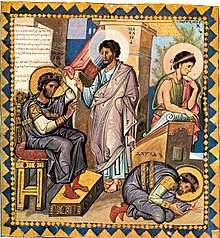 The Reproach of Nathan and the Penance of King David (folio 136v)
The Reproach of Nathan and the Penance of King David (folio 136v)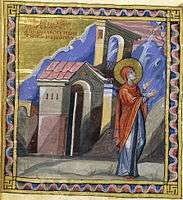 Hannah's Prayer (folio 428v)
Hannah's Prayer (folio 428v)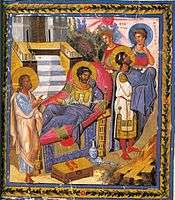 The Healing of Hezekiah (folio 446v)
The Healing of Hezekiah (folio 446v) Isaiah's Prayer (folio 435v)
Isaiah's Prayer (folio 435v)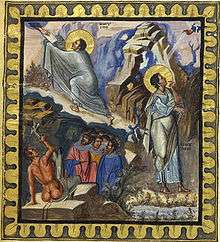 Moses Receiving the Commandments (folio 422v)
Moses Receiving the Commandments (folio 422v)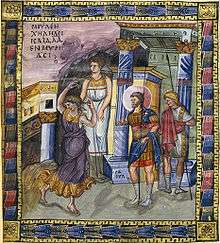 David Glorified by the Women of Israel (folio 5v)
David Glorified by the Women of Israel (folio 5v)
Notes
1. Kurt Weitzmann, “The Ode Pictures of the Aristocratic Psalter Recension,” Dumbarton Oaks Papers 30 (1976): 67–84, here p. 73; and idem, “The Psalter Vatopedi 761: Its Place in the Aristocratic Psalter Recension,” Journal of the Walters Art Gallery 10 (1947): 21–51, here p. 47.
References
- Wander, S. (2014). The Paris Psalter (Paris, Bibliothèque nationale, cod. gr. 139) and the Antiquitates Judaicae of Flavius Josephus. Word & Image, 30(2), 90-103.
- Anderson, J. (1998). Further Prolegomena to a Study of the Pantokrator Psalter: An Unpublished Miniature, Some Restored Losses, and Observations on the Relationship with the Chludov Psalter and Paris Fragment. Dumbarton Oaks Papers, 52, 305-321.
- H. Buchthal. (1938). The miniatures of the Paris Psalter : A study in middle Byzantine painting /. Nendeln, Liechtenstein :: Kraus Reprint. (book you gotta find at psu)
- Maxwell, Kathleen. (1987). The aristocratic Psalters in Byzantium. Speculum: A Journal of Medieval Studies, 62, 406.
- Lowden, J. (1988). Observations on Illustrated Byzantine Psalters. The Art Bulletin, 70(2), 242-260.